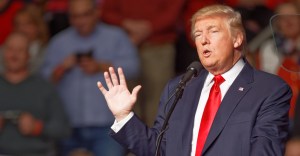More than $1 trillion possible in federal savings, says report handed to Trump team
An organization of IT leaders says the federal government could make changes to save more than $1 trillion during the next decade.
And the Technology CEO Council says its report on how to do it is in the hands of President-elect Donald Trump’s transition team — including Vice President-elect Mike Pence and incoming White House Chief of Staff Reince Priebus.
The potential savings include $500 billion through supply chain and acquisition reform; $205 billion in potential reductions through using big data and analytics as well as cognitive computing to make decisions; and $110 billion through IT modernization.
The report was released publicly Thursday, but a TCC spokesperson told FedScoop that IBM CEO Ginni Rometty shared it last month with the Trump team during the much-documented meeting of tech executives with the president-elect. TCC is the self-described “leading public policy advocacy organization” for the information technology industry, made up of exclusively IT company CEOs.
The federal IT community has not yet seen many direct indicators of how its work might be affected by Trump’s presidency. The report outlines paths the administration could take toward reducing government spending. Bruce Mehlman, executive director of TCC, said those ideas would not mean fewer government services.
“In a world where the fight is over either raising taxes or shrinking government services, there’s a third way,” Mehlman told FedScoop. “And IT can help the Trump administration give taxpayers and citizens more while taking a smaller bite out of th budget.”
The report’s direction and recommendations, Mehlman said, “are very consistent with the president-elect’s stated goal of bringing private sector experience and sensibilities into the government.”
When it comes to funding IT modernization, the report weighs the idea of authorizing working capital funds in each federal agency to encourage leaders to replace legacy systems.
“Such funds could allow agencies to innovate by repurposing unnecessary operations dollars and investing in more efficient technology, and then keeping a portion of the savings,” the report notes, adding that, “This program could prove highly effective, encouraging federal agencies to seek out cost savings and increased productivity while also modernizing outdated IT systems and holding CIOs accountable for spending.”
Another idea considered alone and in tandem with the working capital funds was creating a centralized modernization fund. Legislation that would have created working capital funds in the 24 CFO Act agencies and a centralized fund passed the House last session, but died in the Senate.
Mehlman said a centralized fund would be “a very positive step,” as well reshaping federal budgeting to allow upfront investments that can be proven to save money over time.
“What you find is upfront investments to realize long-term savings work everywhere except Washington,” he said. “The budgetary rules exist to prevent un-meetable promises and you don’t know if the next Congress is going to carry forward the last Congress, or the next secretary will stay on the same plan, so they’ve decided that they can’t see past one year.”
But he noted: “The challenge is, given how critical IT is to the successful mission of every agency now, agencies are going to need a modern and private-sector approach to leveraging them.”
To drive modernization, the report recommends appointing a strong federal CIO who can coordinate efforts across government.
“First you want to have an empowered federal CIO with this as their mission, that has the full faith and credit of the [Office of Management and Budget] and the White House and leads the Federal CIO Council,” Mehlman said. “And that comes up with an aggressive but realistic strategy, and then is relentless in demanding accountability as they execute on the strategy.”
When it comes to empowering agency CIOs, Mehlman said, “In the companies I’m aware of that are most effective in leveraging technology to be efficient and effective, CIOs are highly-empowered members of the senior strategy team. And I don’t know why government agencies would be different.”
The report also urges agencies to use cognitive computing technology — such as machine learning and artificial intelligence — to monitor operations and maintenance costs, and estimates that federal government could save about 10 percent on O&M costs by doing so.






